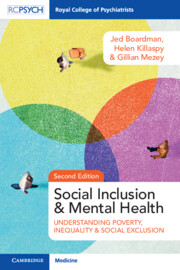Book contents
- Social Inclusion and Mental Health
- Reviews
- Social Inclusion and Mental Health
- Copyright page
- Contents
- Foreword to Second Edition
- Foreword to First Edition (2010)
- Preface
- Acknowledgements
- Chapter 1 Introduction: Poor, Excluded, and Unequal
- Section 1 Social Exclusion, Poverty, and Inequality
- Section 2 Participation of People with Mental Health Conditions
- Section 3 Including People
- Chapter 17 Enabling Social Inclusion for People with Mental Health Conditions: The Role of Mental Health Services
- Chapter 18 Theory into Practice
- Chapter 19 Broadening an Inclusive Approach
- Index
- References
Chapter 17 - Enabling Social Inclusion for People with Mental Health Conditions: The Role of Mental Health Services
from Section 3 - Including People
Published online by Cambridge University Press: 24 November 2022
- Social Inclusion and Mental Health
- Reviews
- Social Inclusion and Mental Health
- Copyright page
- Contents
- Foreword to Second Edition
- Foreword to First Edition (2010)
- Preface
- Acknowledgements
- Chapter 1 Introduction: Poor, Excluded, and Unequal
- Section 1 Social Exclusion, Poverty, and Inequality
- Section 2 Participation of People with Mental Health Conditions
- Section 3 Including People
- Chapter 17 Enabling Social Inclusion for People with Mental Health Conditions: The Role of Mental Health Services
- Chapter 18 Theory into Practice
- Chapter 19 Broadening an Inclusive Approach
- Index
- References
Summary
The final section of the book examines how the social exclusion of people with mental health conditions can be tackled. Health services can play a part in improving health, but these services have traditionally been focussed on treatment and have a limited effect on the broader social determinants. The health of a nation is highly dependent on social, economic, and political forces and broader government policies. The occurrence, course, and outcome of physical and mental health conditions are socially determined and are inequitably distributed in the population. Therefore, broader social, economic, and fiscal policies are needed to address these health inequalities and, in turn, the social exclusion of people with mental health conditions. A public mental health approach is also required. Mental health services play a crucial role in enabling social inclusion for the people they work with. There are continuing challenges for services in preventing the marginalisation of those with the most severe and complex needs. There is a growing evidence base for the effectiveness of specific social interventions that operate at the service or individual level on social inclusion outcomes. For successful implementation, authentic, multi-level stakeholder support and adequate investment is required.
Keywords
- Type
- Chapter
- Information
- Social Inclusion and Mental HealthUnderstanding Poverty, Inequality and Social Exclusion, pp. 347 - 358Publisher: Cambridge University PressPrint publication year: 2022



